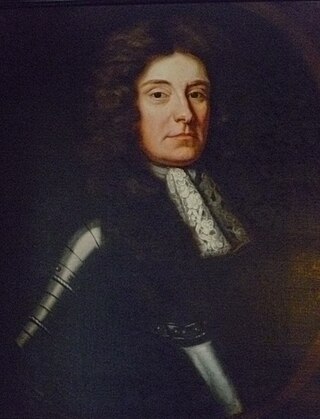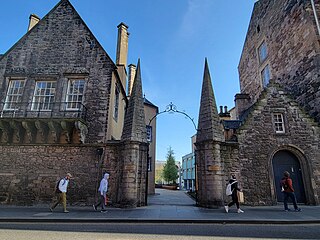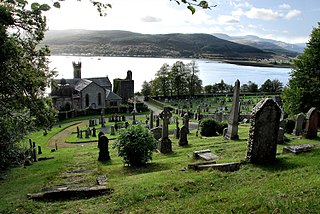
A tower block, high-rise, apartment tower, residential tower, apartment block, block of flats, or office tower is a tall building, as opposed to a low-rise building and is defined differently in terms of height depending on the jurisdiction. It is used as a residential, office building, or other functions including hotel, retail, or with multiple purposes combined. Residential high-rise buildings are also known in some varieties of English, such as British English, as tower blocks and may be referred to as MDUs, standing for multi-dwelling units. A very tall high-rise building is referred to as a skyscraper.

Clan Campbell is a Highland Scottish clan, historically one of the largest and most powerful of the Highland clans. The Clan Campbell lands are in Argyll and within their lands lies Ben Cruachan. The chief of the clan became Earl of Argyll and later Duke of Argyll.

Duke of Argyll is a title created in the peerage of Scotland in 1701 and in the peerage of the United Kingdom in 1892. The earls, marquesses, and dukes of Argyll were for several centuries among the most powerful noble families in Scotland. As such, they played a major role in Scottish history throughout the 16th, 17th, and 18th centuries. The Duke of Argyll also holds the hereditary titles of chief of Clan Campbell and Master of the Household of Scotland.

Gourock is a town in the Inverclyde council area and formerly a burgh of the County of Renfrew in the west of Scotland. It was a seaside resort on the East shore of the upper Firth of Clyde. Its main function today is as a residential area, extending contiguously from Greenock, with a railway terminus and ferry services across the Clyde.

Gilwell Park is a camp site and activity centre in East London located in the Sewardstonebury area of Waltham Abbey, within Epping Forest, near the border with Chingford. The 109-acre (44 ha) site is owned by The Scout Association, is used by Scouting and Guiding groups. As the original base of leadership training in the Scout movement, it is an important site of the worldwide Scouting movement.

Lochwinnoch is a village in the council area and historic county of Renfrewshire in the west central Lowlands of Scotland. Lying on the banks of Castle Semple Loch and the River Calder, Lochwinnoch is chiefly a residential dormitory village serving nearby urban centres such as Glasgow and Paisley. Its population in 2001 was 2628.

The University of Exeter offers approximately 5,900 purposebuilt student bed spaces for its students. The majority of its residences are located on campus, although 30% of self-catered accommodations are located off-campus.

Archibald Campbell, 9th Earl of Argyll was a Scottish peer and soldier.

Lochearnhead is a village in Perthshire on the A84 Stirling to Crianlarich road at the foot of Glen Ogle, 14 miles north of the Highland Boundary Fault. It is situated at the western end of Loch Earn where the A85 road from Crieff meets the A84.

Cregagh is an area southeast of Belfast in County Down, Northern Ireland. It is the name of a townland and has been adopted as the name of an electoral ward of Belfast City council. The townland dates back to medieval times, when it was part of the territory held by the O'Neills of Clannaboy. The area is centred on the Cregagh Road. The Woodstock/Cregagh Road is a continuous arterial route in the city, with the Woodstock making up the lower half of the route and the Cregagh the upper half. It runs from the Albertbridge Road, close to the Short Strand, to the A55 Outer Ring road.

The Moray House School of Education and Sport is a school within the College of Arts, Humanities and Social Science at the University of Edinburgh. It is based in historic buildings on the Holyrood Campus, located between the Canongate and Holyrood Road.
Girlguiding Cymru is one of the nine regions of Girlguiding UK. It serves the approximate area of Wales, although the boundaries are not exact. In 2023, there were 11,000 youth members and over 3,000 volunteers. The chief commissioner of Girlguiding Cymru is Bev Martin.

Foxlease is a training and activity centre of Girlguiding near Lyndhurst, Hampshire, UK. The Foxlease estate has been owned and managed by the Guides since 1922. The estate is 65 acres (260,000 m2) and the main house is known as The Princess Mary House, in honour of her marriage. Foxlease hosted the Guides' Third International Conference, the Sixth World Conference and also the first World Camp.

Broneirion is a Victorian house and grounds on the hillside across the River Severn from the village of Llandinam. It was built by Welsh industrialist David Davies. It has been used as a training centre for Girl Guides since 1946 and has been owned since 1992 by Girlguiding Cymru. In 2022, they announced the mansion had been put on sale and the centre would be closed.
Scouting in Scotland is largely represented by Scouts Scotland, a registered Scottish Charity No. SC017511 that is affiliated to the Scout Association of the United Kingdom. The Baden-Powell Scouts' Association also has a presence in Scotland.

Girlguiding Scotland is part of the worldwide Guiding movement. It is the country's largest voluntary organisation for girls and young women with 61,375 members in 3,500 units throughout Scotland.

Craignish Castle is located on the Craignish peninsula in Argyll, western Scotland and is a category B listed building. The present castle includes a 16th-century tower house, the seat of the Campbell family of Craignish and Jura. In the 19th century it was sold to the Trench-Gascoigne family of Parlington Hall, Yorkshire, who built a large extension to the tower. In the later 20th century the house was restored and parts of the 19th-century extension were demolished. The result of these extensions and styles from various centuries have made the castle a Scottish baronial masterpiece. It has previously been known as Loch Beag.

Dungiven Castle is a 19th century castle in Dungiven, County Londonderry, Northern Ireland.

Caythorpe Court is a Grade II* listed former hunting lodge situated about one mile to the east of Caythorpe, Lincolnshire, England. It was originally built in 1901 for Edgar Lubbock, a brewer and banker, to the designs of Sir Reginald Blomfield. In 1946 it became the Kesteven Agricultural College, which was renamed the Lincolnshire College of Agriculture and Horticulture from September 1980. The college became the De Montfort School of Agriculture, but the site was closed in 2002. After being sold to property developers, who proposed to use it to house asylum seekers, it was acquired by PGL who now operate it as a centre for adventure based holidays for adults and children.

Kilmun Parish Church and Argyll Mausoleum in Kilmun, Argyll and Bute, Scotland, consists of St Munn's Church, as well as the adjacent mausoleum of the Dukes of Argyll and a historically significant churchyard. The complex is located on the summit of a slight knoll about ten metres from the shoreline of the Holy Loch on the Cowal Peninsula in Argyll, Scotland. The existing church dates from 1841 and occupies the site of an older, medieval church. A partly ruined tower from the medieval period still stands to the west of the present building.


















